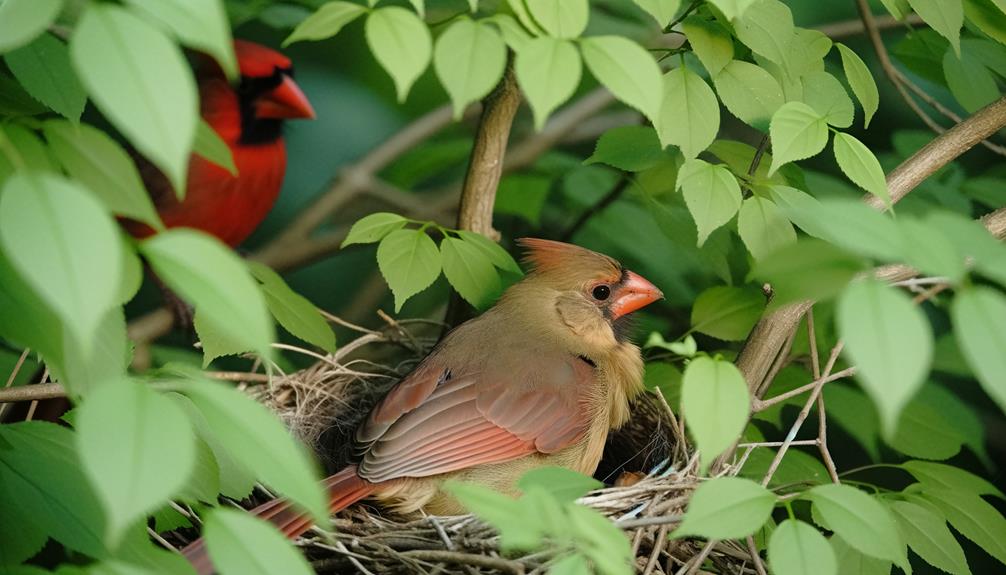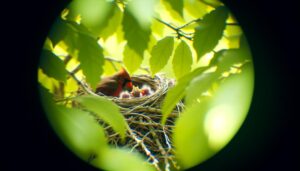How Do Cardinals Share Nesting Duties?
Cardinals share nesting duties in a coordinated partnership. You'll notice the female carefully choosing a nesting location and building it with accuracy using twigs, bark strips, and leaves.
Meanwhile, the male diligently provides materials like grasses and twigs. Both parents incubate the eggs, maintaining a balanced temperature and protecting against predators.
The male also plays an essential role in feeding the female and defending their territory. This detailed division of labor guarantees ideal conditions for their offspring's growth.
Delving deeper, you'll discover more about their remarkable cooperation.

Key Takeaways
- Both male and female cardinals participate in incubating the eggs.
- The female meticulously selects the nesting site and constructs the nest.
- The male provides materials and supports by feeding the female.
- The female maintains temperature and humidity levels for egg incubation.
- Both parents share responsibilities to ensure the nest's safety and the chicks' feeding.
Cardinal Nesting Behavior

Cardinal nesting behavior exhibits a fascinating division of labor, where both the male and female contribute substantially to the construction and maintenance of the nest.
You'll observe that the female typically selects the nesting site, often choosing dense shrubs or low trees to guarantee protection. She constructs the nest using twigs, bark strips, and leaves, forming a sturdy cup-like structure.
While the female builds, the male provides materials, such as grasses and small twigs, enhancing the nest's integrity.
Once the eggs are laid, both parents take turns incubating them, ensuring constant warmth. This collaboration exemplifies a balanced partnership, securing the offspring's survival.
Their synchronized efforts highlight the cardinals' innate understanding of shared responsibilities in raising their young.
Role of Male Cardinals
Male cardinals play a key role not only in nest building but also in ongoing parental care, showcasing their significant involvement in the reproductive process. They collect materials for the nest and assist in its construction. During the incubation period, male cardinals feed the female and later help feed the chicks, ensuring their growth and survival.
| Activity | Frequency | Importance Level |
|---|---|---|
| Nest Building | High | Essential |
| Feeding Female | Regular | Necessary |
| Chick Feeding | Constant | Vital |
| Territory Defense | Persistent | Crucial |
| Singing | Daily | Important |
Their ability to defend territory and provide food exemplifies their integral role. Male cardinals' active participation is indispensable for the species' reproductive success.
Role of Female Cardinals

While the males are busy defending the territory, female cardinals meticulously select the nest site and take the lead in incubating the eggs.
You'll find that females exhibit remarkable precision in choosing locations with best cover and minimal predator exposure. They're responsible for laying and warming the eggs, ensuring proper embryonic development.
During this period, they maintain a vigilant schedule, rarely leaving the nest except for short breaks to forage. Their dedication to maintaining constant temperature and humidity levels within the nest is essential for the survival of the offspring.
You'll observe that their role is indispensable, as they balance both nurturing the future generation and coordinating with the males for food and protection.
Nest Building Process
As the female carefully selects the nest site, both partners engage in the complex process of constructing a strong and hidden nest. She chooses locations with dense foliage, guaranteeing concealment from predators.
You'll observe the male gathering materials like twigs, bark strips, and grasses, which he delivers to the female. She then intricately weaves these components, creating a compact and resilient structure.
They work in tandem, the female focusing on the interior while the male collects additional materials. This division of labor secures the nest's integrity and camouflage.
Their synchronized efforts result in a well-engineered nest, perfectly suited for the upcoming breeding season. By contributing equally, both cardinals demonstrate an impressive partnership in nest building.
Egg Incubation Duties

During the egg incubation period, the female cardinal mainly takes on the responsibility of keeping the eggs warm and protected. She maintains the eggs receive consistent warmth and sustains ideal conditions.
You'll observe the following:
- Thermoregulation: She uses her body heat to sustain the eggs' temperature, essential for embryonic development.
- Nest Vigilance: She stays alert to potential threats, minimizing disturbances that could harm the eggs.
- Limited Foraging: She only leaves the nest briefly for food, relying on the male to bring sustenance.
- Position Shifts: She periodically rotates the eggs, ensuring even heat distribution and preventing developmental abnormalities.
These meticulous actions underscore her pivotal role in the incubation process, showcasing the cardinal's dedication to future generations.
Feeding the Fledglings
Once the fledglings hatch, both parent cardinals diligently provide them with a diet rich in protein and essential nutrients. You'll observe them collecting insects, spiders, and caterpillars to guarantee the young receive adequate nourishment.
The parents exhibit remarkable coordination, taking turns to forage and feed. By offering regurgitated food, they maximize nutrient absorption for the fledglings. You'll notice the adult cardinals frequently return to the nest, beaks full of sustenance.
This behavior persists until the fledglings are capable of self-feeding. The meticulous feeding schedule guarantees rapid growth and development, vital for the fledglings' survival. Observing this process reveals the cardinals' innate dedication to their offspring's well-being, highlighting their instinctual drive to nurture the next generation.
Parental Cooperation

The meticulous feeding schedule underscores the remarkable level of parental cooperation, where both male and female cardinals share responsibilities to guarantee the fledglings' development.
You'll observe that these vibrant birds work together seamlessly, demonstrating an intrinsic partnership essential for survival. Their cooperation involves various tasks, such as:
- Nest Construction: Both parents gather materials and build a sturdy nest, ensuring a safe environment.
- Incubation: The female primarily incubates the eggs, while the male provides food and protection.
- Feeding: After hatching, both parents equally participate in feeding the fledglings, delivering a balanced diet of insects and seeds.
- Guarding: One parent stays vigilant, protecting the nest from predators while the other forages.
Such cooperation exemplifies an evolved strategy for raising offspring in the wild.
Conclusion
Imagine watching a pair of cardinals, tirelessly working together like synchronized dancers in a delicate ballet. The male, vibrant red, guards the nest and forages for food, while the female, diligently incubates eggs and broods the young.
Their shared dedication guarantees the survival of their offspring. This harmonious partnership, backed by studies showing higher fledgling success rates in cooperative pairs, underscores the beauty of nature's teamwork—an inspiring lesson in unity and commitment.






